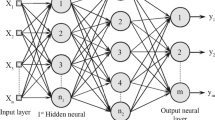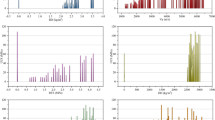Abstract
The knowledge of thermally modified strength properties is crucial in processes such as underground coal gasification, disposal of radioactive wastes in deep geological reservoirs and restoration of fire-damaged structures. However, due to the unavailability of dedicated laboratory equipment, scientists and engineers need to go across various laboratory facilities for testing their desired sample. Further, it delays the process and increases the cost of the project. Since there is a lack of empirical equations that can provide the strength of a thermally modified rock from the strength at room temperature, new predictive models have been developed using multivariate regression analysis (MVRA), artificial neural network and adaptive neuro-fuzzy inference system (ANFIS), to predict the uniaxial compressive strength (UCS) and tensile strength (TS) of both uncooled (NC) and heat-treated (WC) samples of a fine-grained Indian sandstone that has been widely used as a major building material in most of the Indian monuments. The UCS and TS of NC and WC samples have been predicted from the physical properties, viz. temperature (T), density (D), porosity (P), thermal expansion coefficients (EL and EV) and ultrasonic wave velocities (VP and VS). The performance and prediction efficiency of the models have been compared on the basis of performance indices, namely the correlation coefficient (R2), the mean absolute percentage error, the root mean square error and the variance account for. Based on the comparative study, it was concluded that ANFIS provides a relatively closer estimation as compared to MVRA.

























Similar content being viewed by others
Explore related subjects
Discover the latest articles, news and stories from top researchers in related subjects.References
Jaeger JC, Cook NG, Zimmerman R (2009) Fundamentals of rock mechanics. Wiley, New York
Goodman RE (1989) Introduction to rock mechanics, vol 2. Wiley, New York
Sirdesai NN, Mahanta B, Singh TN, Ranjith PG (2016) Elastic modulus of thermally treated fine grained sandstone using non-contact laser extensometer. In: Paper presented at the recent advances in rock engineering (RARE 2016), Bengaluru, India
Abdulagatova ZZ, Abdulagatov IM, Emirov SN (2010) Effect of pressure, temperature, and oil-saturation on the thermal conductivity of sandstone up to 250 MPa and 520 K. J Petrol Sci Eng 73(1–2):141–155. doi:10.1016/j.petrol.2010.05.016
Nara Y, Meredith PG, Yoneda T, Kaneko K (2011) Influence of macro-fractures and micro-fractures on permeability and elastic wave velocities in basalt at elevated pressure. Tectonophysics 503(1–2):52–59. doi:10.1016/j.tecto.2010.09.027
Handin J, Hager RV Jr (1957) Experimental deformation of sedimentary rocks under confining pressure: tests at room temperature on dry samples. AAPG Bull 41(1):1–50
Das R, Sirdesai N, Singh T (2017) Analysis of deformational behavior of circular underground opening in soft ground using three-dimensional physical model. In: 51st US rock mechanics/geomechanics symposium, San Francisco, California, USA. American Rock Mechanics Association
Sirdesai NN, Singh TN, Ranjith PG, Singh R (2017) Effect of varied durations of thermal treatment on the tensile strength of red sandstone. Rock Mech Rock Eng 50(1):205–213. doi:10.1007/s00603-016-1047-4
Hajpál M (2002) Changes in sandstones of historical monuments exposed to fire or high temperature. Fire Technol 38(4):373–382
Hajpál M (1999) Burning effect on sandstones of historic buildings and their petrophysical and mineralogical studies. Period Polytech Civ Eng 43(2):207–218
Torok A, Hajpál M (2005) Effect of temperature changes on the mineralogy and physical properties of sandstones. A laboratory study. Int J Restor Build Monum 11(4):211
Tian H, Ziegler M, Kempka T (2014) Physical and mechanical behavior of claystone exposed to temperatures up to 1000 °C. Int J Rock Mech Min Sci 70:144–153. doi:10.1016/j.ijrmms.2014.04.014
Sirdesai NN, Singh TN, Ranjith PG (2017) Thermal alterations in the poro-mechanical characteristic of an Indian sandstone—a comparative study. Eng Geol 226:208–220. doi:10.1016/j.enggeo.2017.06.010
Sirdesai NN, Singh R, Singh TN, Ranjith PG (2015) Numerical and experimental study of strata behavior and land subsidence in an underground coal gasification project. Proc Int Assoc Hydrol Sci 372:455–462. doi:10.5194/piahs-372-455-2015
Burton E, Friedmann J, Upadhye R (2007) Best practices in underground coal gasification. Lawrence Livermore National Laboratory, Livermore
Sirdesai NN, Mahanta B, Ranjith PG, Singh TN (2017) Effects of thermal treatment on physico-morphological properties of Indian fine-grained sandstone. Bull Eng Geol Env. doi:10.1007/s10064-017-1149-6
ASTM (2008) D3967-08. Standard test method for splitting tensile strength of intact rock core specimen. ASTM International, West Conshohocken. www.astm.org. doi:10.1520/D3967-08
Monjezi M, Khoshalan HA, Razifard M (2012) A neuro-genetic network for predicting uniaxial compressive strength of rocks. Geotech Geol Eng 30(4):1053–1062
Mahanta B, Sirdesai N, Singh TN, Ranjith PG (2017) Experimental study of strain rate sensitivity to fracture toughness of rock using flattened Brazilian disc. Proc Eng 191:256–262. doi:10.1016/j.proeng.2017.05.179
Singh V, Singh D, Singh T (2001) Prediction of strength properties of some schistose rocks from petrographic properties using artificial neural networks. Int J Rock Mech Min Sci 38(2):269–284
Sonmez H, Tuncay E, Gokceoglu C (2004) Models to predict the uniaxial compressive strength and the modulus of elasticity for Ankara Agglomerate. Int J Rock Mech Min Sci 41(5):717–729
Sonmez H, Gokceoglu C, Medley E, Tuncay E, Nefeslioglu H (2006) Estimating the uniaxial compressive strength of a volcanic bimrock. Int J Rock Mech Min Sci 43(4):554–561
Zorlu K, Gokceoglu C, Ocakoglu F, Nefeslioglu H, Acikalin S (2008) Prediction of uniaxial compressive strength of sandstones using petrography-based models. Eng Geol 96(3):141–158
Cevik A, Sezer EA, Cabalar AF, Gokceoglu C (2011) Modeling of the uniaxial compressive strength of some clay-bearing rocks using neural network. Appl Soft Comput 11(2):2587–2594
Gokceoglu C, Zorlu K (2004) A fuzzy model to predict the uniaxial compressive strength and the modulus of elasticity of a problematic rock. Eng Appl Artif Intell 17(1):61–72
Yasar E, Erdogan Y (2004) Correlating sound velocity with the density, compressive strength and Young’s modulus of carbonate rocks. Int J Rock Mech Min Sci 41(5):871–875
Singh TN, Sinha S, Singh VK (2007) Prediction of thermal conductivity of rock through physico-mechanical properties. Build Environ 42(1):146–155. doi:10.1016/j.buildenv.2005.08.022
Gokceoglu C, Zorlu K, Ceryan S, Nefeslioglu H (2009) A comparative study on indirect determination of degree of weathering of granites from some physical and strength parameters by two soft computing techniques. Mater Charact 60(11):1317–1327
Baykasoğlu A, Güllü H, Çanakçı H, Özbakır L (2008) Prediction of compressive and tensile strength of limestone via genetic programming. Expert Syst Appl 35(1):111–123
Sharma L, Vishal V, Singh T (2017) Developing novel models using neural networks and fuzzy systems for the prediction of strength of rocks from key geomechanical properties. Measurement 102:158–169
Armaghani DJ, Safari V, Fahimifar A, Mohd Amin MF, Monjezi M, Mohammadi MA (2017) Uniaxial compressive strength prediction through a new technique based on gene expression programming. Neural Comput Appl. doi:10.1007/s00521-017-2939-2
Hajihassani M, Marto A, Khezri N, Kalatehjari R (2015) Indirect measure of thermal conductivity of rocks through adaptive neuro-fuzzy inference system and multivariate regression analysis. Measurement 67:71–77. doi:10.1016/j.measurement.2015.02.009
Yagiz S, Sezer EA, Gokceoglu C (2012) Artificial neural networks and nonlinear regression techniques to assess the influence of slake durability cycles on the prediction of uniaxial compressive strength and modulus of elasticity for carbonate rocks. Int J Numer Anal Meth Geomech 36(14):1636–1650. doi:10.1002/nag.1066
Cheshomi A, Sheshde EA (2013) Determination of uniaxial compressive strength of microcrystalline limestone using single particles load test. J Petrol Sci Eng 111:121–126
Dehghan S, Sattari G, Chelgani SC, Aliabadi M (2010) Prediction of uniaxial compressive strength and modulus of elasticity for Travertine samples using regression and artificial neural networks. Min Sci Technol (China) 20(1):41–46
Armaghani DJ, Mohamad ET, Momeni E, Monjezi M, Narayanasamy MS (2016) Prediction of the strength and elasticity modulus of granite through an expert artificial neural network. Arab J Geosci 9(1):48
Singh R, Umrao RK, Ahmad M, Ansari M, Sharma L, Singh T (2017) Prediction of geomechanical parameters using soft computing and multiple regression approach. Measurement 99:108–119
Aboutaleb S, Behnia M, Bagherpour R, Bluekian B (2017) Using non-destructive tests for estimating uniaxial compressive strength and static Young’s modulus of carbonate rocks via some modeling techniques. Bull Eng Geol Environ 1–12. doi:10.1007/s10064-017-1043-2
Yesiloglu-Gultekin N, Gokceoglu C, Sezer E (2013) Prediction of uniaxial compressive strength of granitic rocks by various nonlinear tools and comparison of their performances. Int J Rock Mech Min Sci 62:113–122
Singh R, Vishal V, Singh T, Ranjith P (2013) A comparative study of generalized regression neural network approach and adaptive neuro-fuzzy inference systems for prediction of unconfined compressive strength of rocks. Neural Comput Appl 23(2):499–506
Singh R, Kainthola A, Singh T (2012) Estimation of elastic constant of rocks using an ANFIS approach. Appl Soft Comput 12(1):40–45
Sharma L, Vishal V, Singh T (2017) Predicting CO2 permeability of bituminous coal using statistical and adaptive neuro-fuzzy analysis. J Nat Gas Sci Eng 42:216–225
Gautam PK, Verma AK, Maheshwar S, Singh TN (2015) Thermomechanical analysis of different types of sandstone at elevated temperature. Rock Mech Rock Eng 49(5):1985–1993. doi:10.1007/s00603-015-0797-8
CGWB (2010) Groundwater scenario, Dholpur District—western region of Jaipur. Ministry of Water Resources, Government of India, Jaipur
DMG-Rajasthan (2006) Sandstone—Rajasthan. www.dmg-raj.org/sandstone.html. Accessed 15 Aug 2015
UNESCO (2015) India—UNESCO World Heritage Centre. http://whc.unesco.org/en/statesparties/in. Accessed 1 May 2016
Ministry of Coal GoI (2015) Steps for development of underground coal gasification technology. Press Information Bureau. http://pib.nic.in/newsite/PrintRelease.aspx?relid=132935. Accessed 07 Feb 2017
ISRM (1981) Rock characterization testing and monitoring—ISRM suggested methods. Pergamon Press for the Commission of Testing Methods, Oxford
Tian H, Kempka T, Yu S, Ziegler M (2015) Mechanical properties of sandstones exposed to high temperature. Rock Mech Rock Eng 49(1):321–327. doi:10.1007/s00603-015-0724-z
Den’gina NI, Kazak VN, Pristash VV (1993) Changes in rocks at high-temperatures. J Min Sci 29(5):472–477
Yavuz H, Demirdag S, Caran S (2010) Thermal effect on the physical properties of carbonate rocks. Int J Rock Mech Min Sci 47(1):94–103. doi:10.1016/j.ijrmms.2009.09.014
Sharma LK, Singh TN (2017) Regression-based models for the prediction of unconfined compressive strength of artificially structured soil. Engineering with Computers. doi:10.1007/s00366-017-0528-8
Yilmaz I, Yuksek G (2009) Prediction of the strength and elasticity modulus of gypsum using multiple regression, ANN, and ANFIS models. Int J Rock Mech Min Sci 46(4):803–810. doi:10.1016/j.ijrmms.2008.09.002
Zadeh LA (1965) Fuzzy sets. Inf Control 8(3):338–353. doi:10.1016/S0019-9958(65)90241-X
Jang J-S (1993) ANFIS: adaptive-network-based fuzzy inference system. IEEE Trans Syst Man Cybern 23(3):665–685
Loukas YL (2001) Adaptive neuro-fuzzy inference system: an instant and architecture-free predictor for improved QSAR studies. J Med Chem 44(17):2772–2783
Sharma L, Singh R, Umrao R, Sharma K, Singh T (2017) Evaluating the modulus of elasticity of soil using soft computing system. Eng Comput 33(3):497–507
Author information
Authors and Affiliations
Corresponding author
Ethics declarations
Conflict of interest
The authors declare that they have no conflict of interest.
Rights and permissions
About this article
Cite this article
Sirdesai, N.N., Singh, A., Sharma, L.K. et al. Development of novel methods to predict the strength properties of thermally treated sandstone using statistical and soft-computing approach. Neural Comput & Applic 31, 2841–2867 (2019). https://doi.org/10.1007/s00521-017-3233-z
Received:
Accepted:
Published:
Issue Date:
DOI: https://doi.org/10.1007/s00521-017-3233-z




